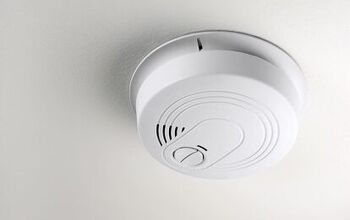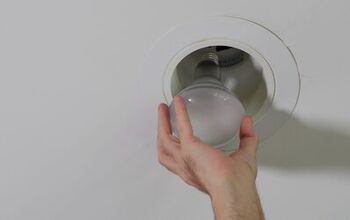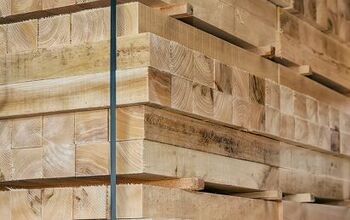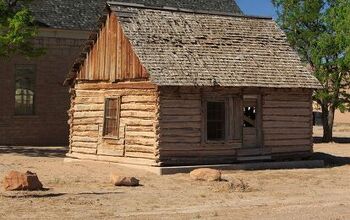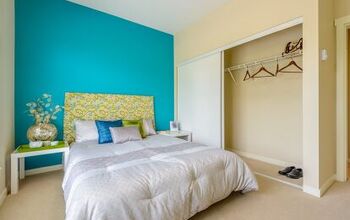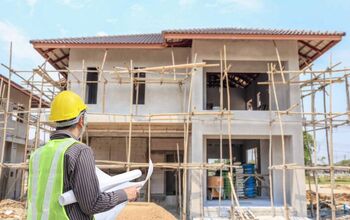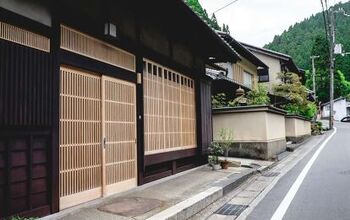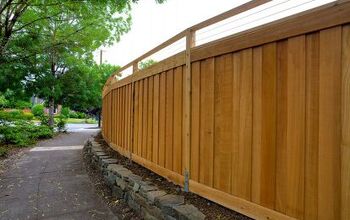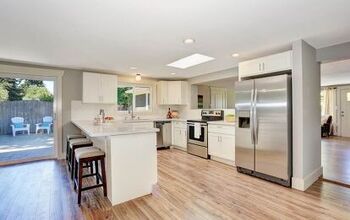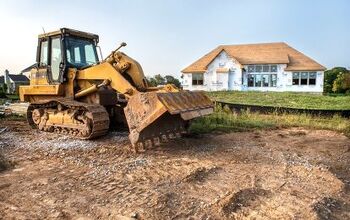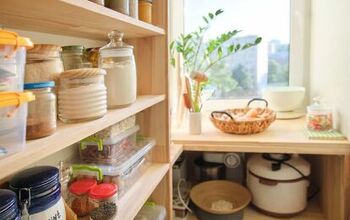Best Flooring Types for Concrete Slab: Plus Pros/Cons & Costs

When you decide what type of flooring to put on top of concrete slab in your home you are essentially working with a blank slate. There are several types of material you can choose from. All of them have pros and cons, but some types are definitely more appealing to most homeowners than others.
The best flooring to put on top of concrete slab are luxury vinyl planks (LVP), luxury vinyl tiles (LVT), ceramic tiles or stone. These flooring types work the best with concrete slab and are the most durable in line with their price. While these four flooring types are normally superior, you may also consider engineered wood products, laminate flooring or carpet as possible options.
There is a lot to consider when you are choosing what type of floor you want to put over concrete slab. First you have the aesthetic appeal to consider. After all, you want it to look great. You also need to think about how long the floor will last, how well it will insulate and how much it will all cost. We made the chart below in order to get an idea of some of the basics about each major flooring type that goes over concrete slab.
| Type of Flooring | Expected Life | Cost per Square Foot | Our Suggestions |
| Luxury Vinyl Tile or Planks (LVT & LVP) | 10 – 20 years | $4 – $7 | For general use areas, one of the best options. |
| Tile or Stone | 75 – 100 | $5 – $40 | Very durable and suitable for wet areas such as kitchens, bathrooms, and laundry rooms |
| Laminate | 10 – 20 | $3 – $8 | Not as durable as vinyl. Don’t use in wet areas |
| Carpet | 5 – 15 | $4 – $11 | Great in places like bedrooms where traffic is minimal |
| Engineered Wood | 20 – 50 | $6 – $25 | Elegant and has better insulating value than laminate. Doesn’t work well in wet areas and requires more maintenance |
| Epoxy Sealed Concrete | 10 – 20 | $3 – $7 | Great in some areas but will wear faster than other floorings. |
Flooring Costs When Installing Over Concrete Slab
When you are looking for the best flooring to put over concrete slab you are likely looking for something that fits comfortably into the constraints imposed by your budget. Typically, in a 2,000 square foot home, the cost of each type of flooring falls within these ranges.
| Type of Flooring | Cost for a The Flooring Material | Installation Costs |
| LVT or LVP | $8,000 to $14,000 | $8,000 to $14,000 |
| Tile (ceramic or Porcelain | $10,000 to $40,000 | $10,000 to $40,000 |
| Stone | $15,000 to $60,000+ | $15,000 to $50,000+ |
| Laminate | $6,000 to 168,000 | $6,000 to $16,000 |
| Carpet | $8,000 to $22,000 | $8,000 to $22,000 |
| Engineered Wood | $12,000 to $25,000 | $12,000 to $50,000 |
| Epoxy Sealed Concrete | $6,000 to $14,000 | $6,000 to $14,000 |
These are broad estimates based on national averages for flooring and installation costs. Specialized flooring or custom installations may be more expensive than these estimated figures.
We will discuss the costs of each flooring type in more detail and what is involved in installing each type of flooring material on a concrete slab.
Six Flooring Types For a Concrete Slab Foundation
As you embark on your mission to find the best type of flooring to put over your concrete floor there is a lot to consider. While each type of flooring has its pros and cons, you should first learn what the six mean options are, and then narrow your scope.
| Flooring Type | Overview |
| Luxury Vinyl Tile or Plank | This is beautiful flooring that can enhance the look of any room in your home. LVT and LVP are known for their durability in any room in your house. |
| Tile or Stone | Tile or stone is perhaps the most durable flooring product you can choose. While the upfront costs may be higher, in the long term, they may be cheaper. Stone or tile is great in wet areas such as bathrooms and laundry rooms. |
| Laminate | This affordable flooring can be used in most rooms in your home and comes in a wide variety of finishes, colors, and textures. Laminate may not be suitable for wet areas. |
| Carpet | Carpet has long been a prime choice for floor coverings. The durability of the carpet depends on the location and the under-padding. Carpet is not a good choice for wet areas. |
| Engineered Wood | Engineered wood products can add a rich and elegant feel to your home. The durability is related to the maintenance and care the engineered wood flooring is given. Don’t install engineered wood in wet areas. |
| Epoxy Sealed Concrete | Epoxy is not really a floor covering but a floor finish. The concrete substrate is ground or sanded smooth. A stain or paint is applied, and then an epoxy sealant protects the finish. Epoxy sealing is suitable for any area in your home, especially areas subject to lots of water. |
Not all the flooring types are suitable for whole-house installations. If you want continuity throughout your home, you must consider these types of flooring that can provide the highest level of durability and are suitable for every environment.
Concrete Slab Considerations When Choosing Flooring
There are some concerns that you should understand before you decide what flooring is best for your concrete floor. Concrete is a great foundation material that is long-lasting, durable, and relatively cost-effective. However, concrete does pose some challenges when selecting and installing floor coverings.
Moisture and Floor Coverings
Concrete appears, on the surface, to be a very dense and impermeable material. However, concrete can be a moisture problem under the flooring. Concrete tends to absorb moisture from the air and from the soil beneath during times of high humidity. The wet ground under a concrete slab is almost always a guarantee for problems.
Basement slabs can be a bigger headache when it comes to moisture. Basements are prone to flooding and leaking during wet seasons if not installed and sealed correctly. This can lead to major problems with the flooring that is not resistant to moisture.
Surface Finish of your Concrete Slab
Finishing concrete is more of an art than a science. Getting large slabs of concrete flat and smooth requires skill and attention to detail. Unfortunately, some concrete contractors may rush the finish and leave you with a concrete slab that is wavy or uneven. Concrete that isn’t finished properly may spall or flake, making installing flooring an even bigger challenge.
Hard floor coverings such as tile and stone need well-finished and flat concrete slabs. Some types of flooring, such as LVT or LVP, may adapt better to uneven slab finishes. However, you should expect any high spots in the slab to show wear in any type of flooring quicker than other parts of the floor.
Insulation Values
Concrete is a hard, dense material. The insulation value of concrete is minimal, but its location on the ground is the biggest problem. In extremely cold climates, concrete slabs can seem colder as the concrete transmits the cold up into the house. A flooring or flooring installation that adds thermal insulation can be a wise choice in some climates.
Comfort is a key element when you choose your flooring. Some flooring types have more insulating value than others. In some situations, underfloor heating can combat cold floors and heat loss through a concrete slab.
The Best Flooring Options To Go Over Concrete Slab
With some basic knowledge and understanding about your flooring choices, let’s further discuss the best flooring types that can go over concrete slabs. We will discuss price points, considerations for locations, and the pros and cons of each type of flooring.
Luxury Vinyl Tile and Luxury Vinyl Planks
Many people confuse Luxury Vinyl Tile or Luxury Vinyl Plank flooring with roll vinyl or linoleum flooring products. Nothing could be further from the truth. Roll Vinyl remains a popular form of flooring for some utility installations. In most homes, roll vinyl is not a consideration.
How LVT and LVP are Made
Luxury Vinyl Tile or Luxury Vinyl Planks are a manufactured flooring product made by layering various materials to create the base of the tile or plank. The base layer is usually a water-resistant material. This is different from waterproof but does provide a high degree of resistance to damage from moisture.
On top of these base layers are the vinyl. The tile or plank’s pattern, color, or design is printed onto this vinyl layer before applying a protective finish. The most critical part of choosing a Luxury Vinyl Tile or Plank product is the thickness of the protective layer on the tile or planks. Residential LVP or LVT products typically have a protective layer between 6 mils and 30 mils. A 12 mil protective layer is at the top of the list for residential installations.
Uses and Locations
Luxury vinyl tile and plank are suitable for almost any location or use in your home. The construction of these flooring types makes them highly resistant to water. Many LVT and LVP products can be installed in bathrooms, kitchens, and laundries without a problem.
The finishes on LVP and LVT also make them useful in high traffic areas such as hallways and entryways. If you wish to install LVP or LVT in a basement where flooding may be an issue, special installation techniques can help protect the tiles or planks. Consult with a professional flooring installer for their best recommendations for these types of installation
Luxury Vinyl Tile and Plank Cost
In general, you can expect luxury vinyl tile or plank to cost between $4 and $7 per square foot. If you opt for thicker protective surfaces or special finishes, the cost can go up accordingly. In most cases, this $4 to $7 estimate will include professional installation.
Installation costs can rise if the concrete slab in your home requires special preparation before the LVT or LVP is laid. This can include filling cracks or repairing spalled concrete, applying special sealers and waterproofing materials, or removing adhesives used with the old flooring.
What are the Advantages of LVT and LVP Flooring?
- Easy Installation – LVT and LVP are relatively easy to install. This makes LVT and LVP flooring products popular with do-it-yourselfers.
- Low Maintenance – The minimal maintenance requirements for LVT and LVP flooring products make them attractive to many homeowners. There is no waxing, polishing, or sealing like many other flooring products. Regular sweeping and mopping is generally the extent of the maintenance required for these types of flooring materials.
- Durability – LVP and LVT are among the most durable flooring products installed over a concrete slab. The thickness of the protective top layer is the key to the durability of the LVT or LVP flooring. Typically, LVT and LVP flooring used in residential installation will last between 10 and 20 years.
- Appearance – The technology used to create the finish appearance allows LVP and LVT a realistic look. In many instances, without a close and intense examination, LVT and LVP flooring are indistinguishable from the real product it mimics. Wood grains and stone surfaces are easily reproduced for a much more expensive look for your home.
- Affordability – LVT and LVP products are among the most affordable floor coverings applied over a concrete slab. At $4 to $7 per square foot, very few floor coverings can provide the look and durability of LVT and LVP flooring.
LVT and LVP flooring is rapidly becoming the choice of floor coverings for many builders and homeowners. Even in upscale, more expensive homes, LVT and LVP are finding a place.
Disadvantages of LVT and LVP Flooring
- Return on Investment – Unfortunately, installing LVT or LVP flooring on your concrete slab won’t do much to raise the value of your home. This may not be a huge consideration for many homeowners, but it should be considered when choosing your floor coverings.
- Wear and Tear – LV and LVT flooring is not impervious to damage. Normal wear and tear are expected, and your flooring will eventually show some evidence of this. LVT and LVP are prone to scratching and scuff marks that can damage the surface. High traffic areas will show this kind of wear more rapidly. Since LVP and LVT are not repairable, major damage or wear will require replacement.
All flooring suffers normal wear and tear over time. LVT and LVP are no exception. However, suppose you choose the right type and quality of LVT or LVP flooring. In that case, you can expect many years of service with minimal maintenance.
Tile or Stone Flooring
Tile flooring usually includes ceramic or porcelain tiles. Natural stone products like travertine are also cut into tile-sized pieces for use as flooring. Different installation methods are required for stone and tile, so make sure your installer understands what product you have chosen. There are also differences in moisture absorption and durability to consider.
Moisture Considerations
Porcelain tile is more resistant to moisture absorption than either ceramic tile or natural stone. However, when properly installed, ceramic, porcelain, or natural stone tiles all are suitable for installation on a concrete slab and in wet areas.
Tile and stone make particularly good floors in kitchens, bathrooms, and laundry rooms where spills can be expected. Ceramic tiles and porcelain tiles both offer surfaces that are stain-resistant and withstand household cleaners well.
Durability and Care
Tile and stone are probably the most durable floor coverings you can apply to a concrete slab. Some tile and stone products can be expected to last 100 years under normal use and with proper maintenance.
In general, porcelain tiles are stronger than ceramic tiles. This makes porcelain tiles more resistant to chipping or cracking than ceramic tiles. Stone tiles vary in their hardness and durability. If you want the look of natural stone tiles, consulting with an expert in stone flooring is a good idea.
Tile and stone floors do require regular maintenance. The grout used between most tiles should be regularly cleaned and repaired. Some types of stone tiles must be deep cleaned and sealed to maintain their appearance. This can be an added cost to maintaining tile or stone flooring.
Installation Over Concrete Slab
Installing tile or stone over a concrete slab is more time-consuming than other types of flooring. Tile and stone are not forgiving or uneven concrete slabs or concrete slabs with damage such as cracks or spalling. These problems must be remedied before the tile is installed. This can add to the cost of the installation.
On average, you can expect to pay between $5 and $30 per square foot to install tile or stone in your home. In many instances, the cost of installation is included in the cost of the tile. Check with your flooring dealer about installation costs.
Purchasing Tile and Stone Flooring
You will find that the choices you have in tile or stone flooring are tremendous. Many people don’t realize the scope of the options until they visit a good flooring dealer. In general, tile or stone flooring runs between $5 and $50 per square foot. These prices may include standard installation. If your concrete slab requires more preparation, costs could escalate.
What are the Advantages of Tile or Stone Flooring?
- Maintenance Costs – Tile flooring is usually easy to maintain. Regular sweeping and mopping will usually keep a tile floor in top condition. Depending on the level of wear and tear, the grout joints in the tile may need occasional sealing to keep them fresh and bright. Stone flooring usually needs the periodic application of a sealer product to protect the surface of the stone.
- Durability – Tile and stone are easily the most durable of all floor coverings you can install on your concrete slab. Some tile and stone products can last 75 to 100 years without problems. If installed properly, tile and stone resist cracking, even if a heavy object is dropped onto the surface.
- Resistance to stains and moisture – High resistance to staining and moisture makes tile and stone floors well suited to installations in bathrooms, laundry rooms and kitchens. Mudrooms and entryways also benefit from tile and stone installations.
- Affordability – While tile or stone may have a higher front-end cost, you may find the long-term costs quite affordable. The durability and life expectancy of stone and tile floors make these the most economical floor coverings you can install.
- Comfort – Many people think of tile and stone as cold and unforgiving. However, advances in technology now allow under-floor heating to be installed between your tile and the concrete slab. This can add a level of comfort to your home that is unexpected and welcoming.
Tile and stone flooring can add a degree of elegance to your home that other types of flooring lack. The vast array of styles, patterns, colors, and finishes available with stone and tile make giving your home a unique look easy and affordable.
Disadvantages of Tile or Stone Flooring
- More Hard Surfaces – Adding large expanses of tile or stone to the floors of your home can create unforeseen problems. Noise can be an issue. Hard surface floors tend to reflect sound and create echoes that can be annoying or disturbing in your home. Tile and stone can also be slippery if moisture coats the surfaces.
- Longevity – The fact that tile or stone can last up to 100 years can be a problem. If you change the décor of your home regularly, great care must be taken in choosing tile or stone flooring that will be compatible with these changes. Removing tile or stone and replacing it for a different look can be expensive and time-consuming.
For many people, tile, or stone floor coverings in parts of their homes are perfect solutions. The water-resistance and permanence of tile or stone are great advantages. However, some people don’t appreciate tile and stone’s hard and unforgiving characteristics, especially in cold climates.
Laminate Flooring
Laminate flooring is a popular choice for installing over concrete slabs. The realistic look for laminate flooring appeals to those who want the look of real wood floors. Real hardwood floors cannot be installed directly on concrete making laminate flooring a good alternative.
New manufacturing technologies have brought laminate flooring from the realm of a cheap look-alike product to flooring that is almost indistinguishable from real hardwood flooring. The construction of laminates has also seen new technologies that make this flooring more durable and more water-resistant.
Concerns About Moisture
Laminate flooring is not waterproof. Some new types of laminate flooring are advertised as water-resistant. However, it is not recommended that laminate flooring be laid directly over concrete. A moisture barrier should be installed between the laminate flooring and the concrete.
Areas that are prone to exposure to water are not good candidates for laminate flooring. Areas such as kitchens, bathrooms, laundry rooms, and mudrooms are not where laminate flooring will work well. The construction of laminate flooring makes them prone to buckling, swelling, or delaminating when exposed to water or other liquids.
Durability and Care
Laminate flooring is relatively durable. Under most circumstances, you can expect a laminate floor installation to last 10 to 20 years with proper maintenance and care. A routine vacuuming, sweeping, and mopping is all that is necessary to upkeep a laminate floor.
Suppose laminate is installed in high traffic areas such as hallways or entryways. In that case, you may notice more rapid wear on the surface finish. Higher quality laminate flooring has thicker surface protection coatings that can mitigate this normal wear and tear.
Installation Considerations
Laminate flooring should be installed with a vapor barrier between the flooring and the concrete slab. This will help prevent the laminate from absorbing moisture from the concrete slab. A good vapor barrier will also help with the noise associated with some laminate flooring.
In general, the concrete slab should be clean and flat for a good laminate flooring installation. Most new laminate flooring is not glued or attached to the concrete slab. Instead, the laminate panels lock together on the edges and float on the concrete slab. A good vapor barrier will eliminate some of the movement and noise.
Many homeowners successfully install laminate flooring themselves. The methods of installation are simple, and the flooring goes in quickly in most instances. This makes laminate flooring a budget-friendly option for many families.
Laminate Flooring Costs
On average, laminate flooring costs between $3 to $8 per square foot. Typically, this doesn’t include installation or underlayment. Depending on the style and material of underlayment you choose, you can expect additional costs of $0.29 to $0.79 per square foot. Installation costs can vary between $3 and $8 per square foot for professional installation
What Are the Advantages of Laminate Flooring?
- Selections and Options – Laminate flooring is available in many finishes, styles, and qualities. You can fit a laminate floor into almost any budget. Manufacturers now offer laminate floors that mimic tile, stone, and various wood finishes and types.
- Installation – Laminate is relatively easy to install. Many homeowners install laminate floors without problems and get a clean and professional finish. Most laminate floor products don’t require glue or special surface preparations. The planks or tiles snap together and interlock with little effort.
- Good at Hiding Slab Problems – Since laminate flooring floats over the concrete slab surface and rests on an underlayment, imperfections in the slap are usually not a problem. Minor imperfections and unevenness won’t hinder the installation of laminate flooring.
- Maintenance and Care – Maintaining laminate floors is an easy process. Regular sweeping and mopping with the appropriate cleaner for your laminate floor finish is the biggest maintenance required. You should follow the recommendations from the floor manufacturer about cleaning products.
Laminate flooring is a great alternative for many homeowners to more expensive flooring materials. Laminate flooring can give a rich and luxurious look to any space.
Disadvantages of Laminate Flooring
- Not Water Friendly – Laminate flooring does not deal well with water. Water tends to invade the joints and cause the laminate substrate to swell, buckle, and delaminate. Laminate flooring should not be used in wet areas such as bathrooms, laundry rooms and mudrooms. Some laminates are rated for kitchen use, but care must be exercised about letting water stand on the flooring.
- No Refinishing Options – Laminate flooring cannot be refinished. No matter how realistic the wood grain or stone looks, you cannot sand and refinish these products. The surface you see is a very thin HD photograph of a surface applied and sealed to the laminate.
- Noise Problems – If a laminate floor is not installed properly with a high-quality underlayment, the floor can be noisy as it moves over the concrete slab. Many people also find the feel of laminate flooring unnatural and unforgiving.
Despite its shortcomings, laminate is a viable option over a concrete slab. Proper installation is a necessity and, for high traffic areas, buying the highest quality laminate flooring is a must.
Carpet
Carpet is a long-time favorite among homeowners as a floor covering. When installed on a concrete slab, carpet tends to bring a warm and comfortable feel to the foot. Installing carpet on a concrete slab is a well-understood process and works well in most cases.
Carpet comes in an amazing variety of styles and materials and with a broad price range. Generally, you should consider these options when choosing a carpet for your home.
- Nylon carpets are extremely durable and can be treated with stain-resistant materials. Nylon works well in high-traffic areas. Nylon is a favorite with families with children and pets.
- If you want an economical carpet that is durable and luxurious, m polyester is a great material. Many people choose polyester carpets for bedrooms and family rooms.
- Olefin carpets are usually found in commercial carpets where high traffic resistance and stain protection are major considerations.
- Wool carpets are the premium material. Wool resists dirt and may last many years. If luxury and beauty are key priorities, wool is an excellent choice for a carpet.
Installation Considerations
Carpets can be problematic where moisture infiltration occurs through the concrete slab. In almost every instance, padding of some sort is installed between the carpet and the concrete substrate. If moisture in your home is a problem, adding a waterproof moisture barrier under the carpet padding is necessary.
Carpet is forgiving of imperfections in the concrete slab of your home. However, cracks and other imperfections may be noticeable in the carpet or lead to abnormal wear patterns. Proper surface preparation is essential for the long-term health of your carpet.
Durability and Care
Carpet is probably the least durable of the floor coverings we consider. High-traffic areas can begin to show wear in just a few years. Normally, carpeting should last between 5 to 15 years, depending on where it is installed.
Carpet does require more maintenance than other types of floor coverings. Frequent vacuuming will keep your carpet looking fresh and new. Periodic cleaning by a professional carpet cleaner is also recommended. Avoid the homeowner’s do-it-yourself carpet cleaning machines. These machines can leave too much moisture and cleaning agents in your carpet.
Carpet Costs
Carpeting typically costs $4 to $11 per square foot. However, premium styles and pile thicknesses can run more, and wool carpets tend to be on the upper end of the price range. You should also figure the cost of underlayment and padding. Typically carpet padding costs on average $1.75 per square foot.
Installation is also an additional cost and runs between $1 and $4 per square foot. Installing carpets is not usually a project that homeowners can tackle. You are well-advised to allow professionals to install your carpets for the best results.
What Are the Advantages of Carpet?
- Comfort and Feel – Carpet softens the hard surface of a concrete slab and provides a warm and comfortable feel under your feet. This makes carpet a favorite floor covering in bedrooms and family rooms on a concrete slab substrate.
- Selections – Carpet is available in a wide selection of materials, styles, colors, and grades. This allows homeowners almost any look for the décor of their home at a price that fits their budget.
- Safety and Convenience – Carpet provides a safe and convenient surface in your home. Families with children who spend a lot of time on the floor will appreciate the carpet for its cushioning abilities. Carpets tend to be less slippery and prone to trips than harder surfaces.
- Quietness – Carpets tend to muffle sound, making areas that are carpeted less noisy. Carpet is especially useful in playrooms, recreation rooms, and entertainment areas like home theaters.
Many families opt for carpeting in areas where comfort and warmth are appreciated. Bedrooms and living areas are the usual locations for carpeting over a concrete slab.
Disadvantages of Carpet
- Maintenance and Care – Carpet requires regular and often intensive care to maintain its beauty and functionality. Daily vacuuming in some areas is often necessary. A periodic deep cleaning by a professional cleaning company is recommended. Prompt attention to repairs on splits or tears is important.
- Allergies – Carpets often collect dust and other allergens. Anyone in the home with carpeting can be affected by these problems. These materials can be hard to remove because of their size and configuration.
- Durability and Life Expectancy – Carpet is more susceptible to normal wear and tear than other floor coverings. High-traffic areas may begin to show noticeable wear after only a few years. In general, you should expect your carpet to last from 5 to 15 years.
- Not for Wet Areas – Carpets should not be installed in wet areas such as bathrooms, kitchens, and laundry rooms. Exposure to water can shorten the lifespan of your carpet or result in mold growth which is a health danger under any circumstances.
Carpet certainly has its place in a home. Bedrooms, family rooms, and playrooms all benefit from the carpet on a concrete slab. However, the short lifespan and higher maintenance are considerations when making floor covering choices.
Engineered Wood Flooring
Unlike laminate flooring, which mimics wood, engineered wood flooring has real wood on the finished layer. The wood is typically laminated to a substrate that can be vinyl or other stable material. The thickness of the wood layer determines the quality of the engineered wood flooring.
The substrate is usually a core board that provides strength and stability to the real wood laminated to the top. A protective coating or layer is applied to the wood surface. This construction makes engineered wood flooring more moisture-resistant and suitable for installation on concrete slabs.
The Types of Engineered Wood Flooring
Engineered wood flooring comes in three types. These types have different uses and applications.
- Multi-ply Engineered Wood Flooring – This is the most popular type of engineered wood flooring. For appearance and feel, multi-ply engineered wood flooring most closely mimics real hardwood flooring.
- 3-Ply Engineered Wood Flooring – As the name implies, 3-ply engineered wood flooring has three layers. The 3 layer construction makes this type of engineered wood flooring resistant to over-expansion. The feel of 3-ply flooring is very much like real hardwood, but it is not as strong as multi-ply flooring.
- HDF Engineered Flooring – HDF flooring is not seen or used very often. The major benefit to HDF engineered flooring is its ease of installation. Most HDF flooring uses a click system to connect the flooring.
The Look and Feel of Real Hardwood
Many people want the look and feel of a real hardwood floor in their home. Hardwood flooring cannot be installed over a concrete slab. Hence, the next best alternative is an engineered wood flooring product.
Engineered wood flooring products combine real hardwood’s rich look and feel with the moisture resistance of a manufactured product. This makes them ideal in many instances where hardwood is the preferred flooring material.
Installation Considerations
Generally, installing an engineered wood floor is much like installing a laminate floor. A vapor barrier or underlayment is recommended between the concrete slab and the flooring. Some engineered wood flooring is glued to the concrete surface and requires different methods.
When the engineered wood flooring is glued to the concrete slab, particular attention to cleaning and preparing the concrete surface is necessary. Ensuring that the slab is level and even and that any imperfections are corrected is imperative.
Care and Maintenance
Normal care and maintenance will keep most engineered hardwood floors looking fresh and new for many years. Regular sweeping and mopping are the typical maintenance. With care, engineered wood flooring can be expected to last 20 to 50 years in most situations.
Cost of Engineered Wood Flooring.
In general, engineered wood flooring is in the mid-range of floor covering costs. You can expect to pay between $6 and $25 per square foot for quality engineered wood flooring. This may or may not include installation or additional materials such as adhesives or underlayments. Any repairs to your concrete slab will also increase the cost of installing engineered wood flooring.
What are the Advantages of Engineered Wood Flooring?
- Varieties and Selections – A wide variety of wood, colors, and finishes are available when selecting engineered wood flooring. Different species of wood can bring a unique look to your home’s floors.
- Moisture Resistance – Moisture resistance is a huge benefit of engineered flooring. This moisture resistance makes installing this type of flooring where regular hardwood flooring won’t work.
- Durability and Strength – Multi-ply construction adds a level of strength and durability that many other types of flooring lack. This durability makes engineered flooring an option for high-traffic areas in your home.
If you want the look and feel of real hardwood flooring in your home, engineered wood flooring is a perfect solution when you live on a concrete slab. Using engineered wood flooring is often more economical than real hardwood.
Disadvantages of Engineered Wood Flooring
- Expense – Engineered flooring products are more expensive than other flooring options for installation on a concrete substrate. The longer expected lifespan of engineered wood floors helps mitigate this cost difference.
- Sunlight Considerations – Engineered wood flooring has real wood laminated to a substrate. The wood may fade if exposed to direct sunlight. This can be a problem in homes with large expanses of windows that allow direct sunlight on the floor.
- Moisture as a Problem – Engineered wood flooring is not waterproof. This type of flooring should not be installed in areas subject to water, such as bathrooms and laundry rooms.
Engineered wood flooring isn’t the solution for every area of a home. However, engineered wood flooring can add a sense of luxury and elegance when placed in the proper location.
Epoxy Sealed Concrete
A new option for concrete slabs is an epoxy coating over a stained or painted concrete surface. This eliminates the need for another layer of flooring over the concrete and can produce very elegant and attractive floors.
Not really a floor covering, Epoxy finishes are versatile, limited only by your imagination and the applicator’s skill. The stain under the epoxy coating can mimic stone, tile, or a solid color. The epoxy surface helps deal with uneven concrete and other surface blemishes and damage.
Cost of an Epoxy Floor Installation
Applying an epoxy floor surface typically runs between $3 and #7 per square foot. The complexity of the finish and the level of preparation needed on the concrete surface are the controlling factors.
Maintenance and Durability
Low maintenance is a quality of epoxy concrete floor finishes. Damp mopping and sweeping the floor are about the only maintenance required.
Properly applied epoxy finishes can last up to 20 years. However, in high-traffic areas, visible wear may show sooner than later
What Are the Advantages of an Epoxy Concrete Floor Finish?
- Moisture Resistance – The epoxy layer on the top of the concrete finish provides a waterproof barrier from both directions. Moisture can penetrate the concrete slab, and spills or even standing water can’t be absorbed by the concrete.
- Stain Resistance – Epoxy finishes are stain-resistant. Spills of even the harshest household chemicals typically leave no marks or stains.
- Style and Look – Your imagination is the limit to what your floor can be. If you want a unique look on your floor, an epoxy finish is a perfect solution. Get creative and artistic with the finishes applied to the concrete before the epoxy coating is applied.
- Health and Safety – Surprisingly, epoxy finishes can be applied non-slip, making them safe even in wet environments. In addition, the epoxy coating is non-allergenic and doesn’t emit toxic or noxious gasses.
The disadvantages of Epoxy Concrete Floor Finishes
- Temperature and Comfort – Epoxy doesn’t provide any insulation value to your floor. You are basically walking and working on a concrete slab.
- Hard and Unforgiving – Epoxy can be unforgiving in areas where you stand or move about a lot. There is no cushion or padding to absorb some of the punishment that your feet can endure while standing and moving.
- Hard to Refinish – If your floor becomes worn or outdated, refinishing a concrete epoxy surface can be difficult. The epoxy must be ground away and the top layer of the concrete removed to eliminate any stains or coloring.
An epoxy concrete floor finish is a wonderful option in areas such as laundry rooms, basements, and mudrooms. You can get creative with the finish and enjoy a waterproof and stainproof floor that is easy to clean and maintain.
Finding the Best Floor Covering for your Concrete Slab
When it comes to finding the best flooring to put over concrete slab, it is hard to go wrong with luxury vinyl tile or plank. Ceramic tile and stone are also good options, but might be more costly. There are many directions you can go, but the right choice for you will depend on your specific floor, aesthetic and budget.

Dennis is a retired firefighter with an extensive background in construction, home improvement, and remodeling. He worked in the trades part-time while serving as an active firefighter. On his retirement, he started a remodeling and home repair business, which he ran for several years.
More by Dennis Howard



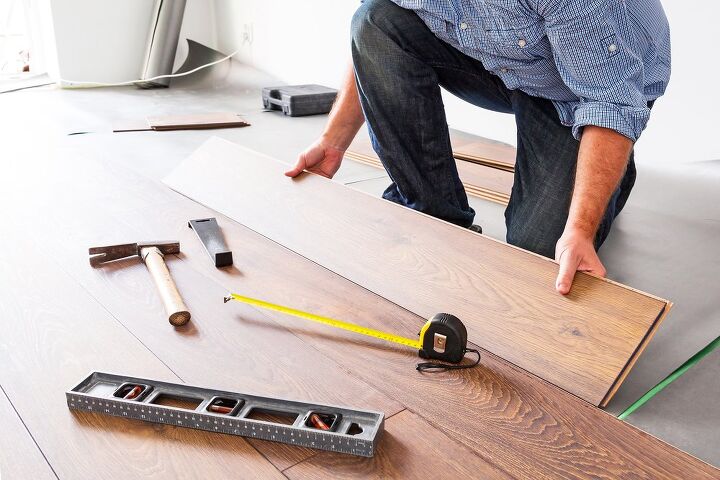






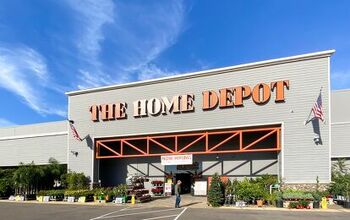
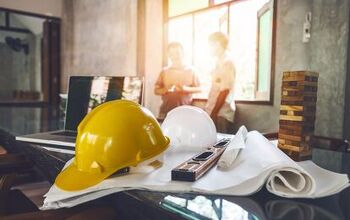
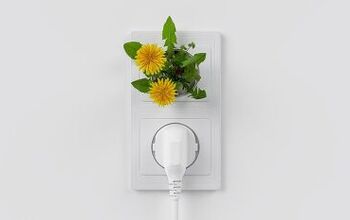
![10 Best Cordless Leaf Blowers – [2022 Reviews & Ultimate Guide]](https://cdn-fastly.upgradedhome.com/media/2023/07/31/9070789/10-best-cordless-leaf-blowers-2022-reviews-ultimate-guide.jpg?size=350x220)
![10 Best Electric Lawn Mowers - [2022 Reviews & Top Rated Models]](https://cdn-fastly.upgradedhome.com/media/2023/07/31/9070486/10-best-electric-lawn-mowers-2022-reviews-top-rated-models.jpg?size=350x220)
